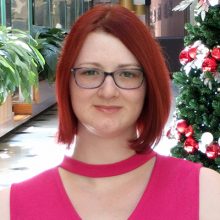Amazing things are going to happen

My name is Kathryn Lyons and I’m going to change the world.
Eight months ago, I started a business called Accessibili-t with my mother. We found a lot of problems with the accessible facilities in our community and in how those facilities were viewed by the community, especially toilets. So we started a business to change things. In these short eight months, Accessibili-t has grown and become something that can and will change billions of people’s lives for the better.
Firstly, I want to tell you a little bit about myself. I’m living in Brisbane with my mother as my carer and we’ve always been passionate about fostering inclusion in our community. I have Microcephaly combined with an Unidentifiable Connective Tissue Disorder, global in nature, progressive degenerative. An extreme form of hypermobilìty, as well as twisting bones, dysautonomia, heart and severe dynamic airway collapse issues. That means that I am either in a wheelchair or in bed and that I am constantly and consistently hounded by chronic fatigue, which at times affects my ability to communicate: resulting in my need for assistance with various communication devices.
This has really given me a unique perspective on our community, our infrastructure and our lives because I see all the failings in the way things are designed. Most things in society designed for use by people with disabilities are designed by the able-bodied people, with limited input on how disabled users utilize and access these things. As they do not fully understand the perspective of the person with the disability, so they invariably design it for an able bodied person.
In about February 2016, mum and I started talking about what bothered me in the local community. We discussed the problems with toilets and decided to create a better perception in society on what was really needed to make public toilets work.
Back in May, the federal election was in full swing and in an attempt to capture the attention of visiting politicians, my mum and I began to go around the community focusing on inclusivity, especially regarding bathrooms. We looked at what was currently in place in shopping centres and public spaces and talked not only to the politicians but to people who used those facilities. The difference in responses between these two groups was astounding. It highlighted that while politicians thought the toilets were “state of the art” there were actually lacking the type of infrastructure that would allow people to go to the bathroom hygienically and with dignity.
We began to realise this was bigger than just us and we turned it into an awareness campaign.
The seeds of Accessibili-t were growing.
During the election I invited political candidates to come and push my wheelchair, to simply walk with me around the shopping centres, parks and community spaces where they were campaigning. I showed them in under five minutes how many glaring design flaws were part of these everyday spaces and how they limited accessibility and inclusiveness.
Most people don’t realise that ‘accessible’ toilets don’t live up to their name.
Once we contacted community support groups and began to design solutions however everyone realised how simple and effective the changes needed to be. We contacted all three levels of government and private corporations as well as Queensland University of Technology (QUT). With this support we are now working on designing and implementing truly accessible toilets in our community.
Truly accessible and inclusive facilities, designed for people with many differing kinds of needs, not just physical access.
We want to make practical and innovative solutions that fit easily into existing infrastructure.
We’ve shown that the current Australian Standards are out of date – that which is said to be state-of-the art now lags behind what is required to be safe, hygienic and respectful. Everyone has different limitations in their lives, some more than others. Sometimes, these limitations can almost remove someone from society entirely. We’ve been working on enabling people to reconnect with their communities. That’s how we get inclusive design – we change people’s perspectives. Inclusive design doesn’t just mean changing physical spaces, it means changing the way people think about these spaces; perspective.
Everyone has potential in their own way, but we often limit ourselves in what we think is or isn’t possible. I get the question of why I’m doing what I am a lot, and it’s difficult to answer. My first reaction is just to say that I’m doing it because it needs to be done. There are problems that no one seems to see or want to fix that we’re going to improve. There are people whose lives are disadvantaged simply because systems that everyone else takes for granted, like using toilets, were designed without taking into consideration, just how everyone uses them.
At the end of the day, I suppose it comes down to what inclusion really means.
I want to improve the independence and quality of life for all people. I’m determined to see this through, to change communities throughout Australia and the world. We’re starting by changing toilets but we’re not stopping there. Accessibili-t is about inclusion for all and we’re not stopping until we’ve changed the world. You’ll be hearing more about what this means!
That’s why our motto is “amazing things are going to happen.”
*This piece was written with the assistance of Declan Winterton and Vicki Lyons


Join the conversation